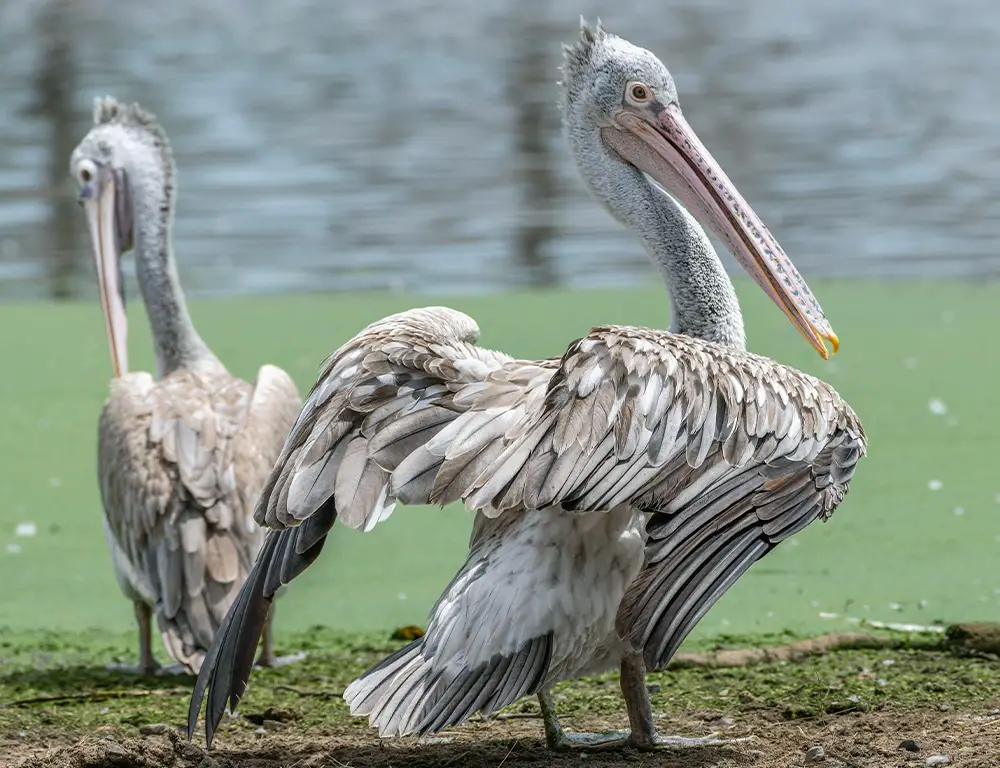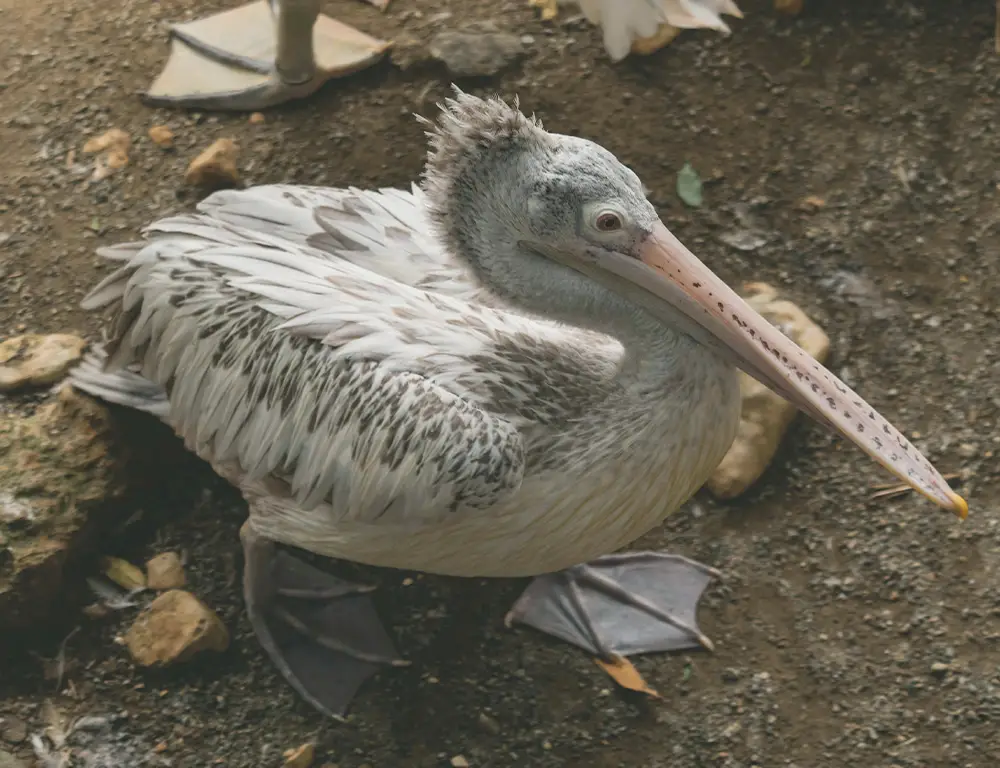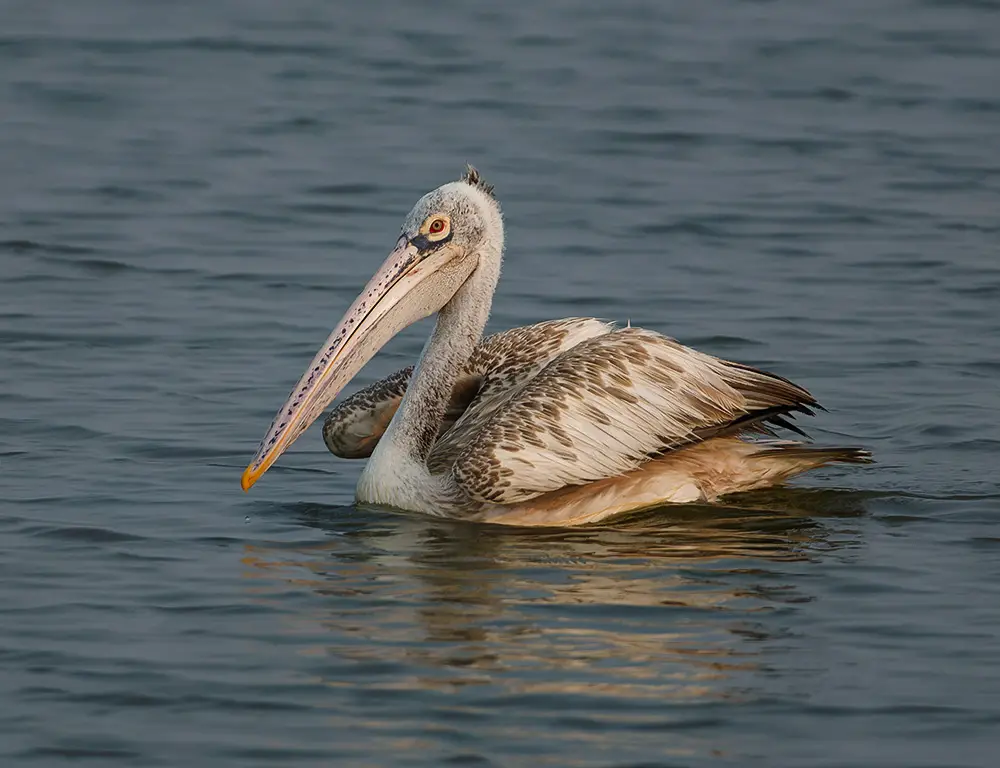In the realm of ornithology, one encounters the intriguing Spot-Billed Pelican, a captivating member of the Pelecanidae family.
Scientifically known as Pelecanus philippensis, this bird species is distinguished by its spotted bill, a feature that lends it its name.
Predominantly inhabiting southern Asia, the Spot-Billed Pelican commands attention with its impressive wingspan, reaching up to 2.5 meters (8.2 ft) in flight.
Despite its majestic presence, the species faces vulnerability, classified as ‘Near Threatened’ on the IUCN Red List due to habitat loss and disturbances at nesting colonies.
Renowned for its social nature, Spot-Billed Pelicans nest colonially in trees along water bodies, providing a picturesque sight for bird enthusiasts.
However, amidst their charm lies a pressing need for conservation efforts, underscoring the impact of human activities on global wildlife populations.
Physical Characteristics of the Spot-Billed Pelican: Insights Into Size, Plumage, and Adaptations

The Spot-Billed Pelican (Pelecanus philippensis) possesses several distinctive physical characteristics that set it apart from other bird species. Here’s a detailed overview:
Size
Spot-Billed Pelicans are large birds, measuring between 140 to 152 centimeters (55 to 60 inches) in length from the tip of the beak to the tail end.
Their wingspan can extend up to an impressive 220 to 250 centimeters (87 to 98 inches), making them one of the more prominent members of the pelican family.
Weight
Typically, Spot-Billed Pelicans weigh between 4.1 to 6 kilograms (9 to 13 pounds). This weight range reflects their substantial build and size.
Plumage
Their plumage is predominantly white, with additional grey or pinkish tones on their back and wings. The most distinctive feature of the Spot-Billed Pelican is its bill, which is adorned with spots.
These spots vary from a pale yellowish-tan at the base to pink shades towards the tip.
Bill
The bill of the Spot-Billed Pelican is uniquely adapted for its feeding habits. It is large and robust, allowing the bird to scoop up large quantities of fish-filled water. The spots on the bill serve as a distinguishing feature, giving the bird its name.
Feet
Like other waterbirds, Spot-Billed Pelicans have webbed feet that aid efficient swimming and hunting. These webbed feet enable them to navigate through water bodies quickly and precisely.
Overall Appearance
Spot-Billed Pelicans are visually striking birds due to their substantial size, contrasting plumage, and distinctive bill. When observed in their natural habitat, they present a magnificent sight in flight or during activities such as feeding or nesting.
Habitat of Spot-Billed Pelican: Insights Into the Unique Environments They Thrive In

The habitat of the Spot-Billed Pelican (Pelecanus philippensis) is diverse and adaptable, reflecting the bird’s ability to thrive in various aquatic environments across its range.
Here’s an overview of its habitat preferences and nesting habits:
Range
Spot-Billed Pelicans are found across a wide geographical range, primarily in southern Asia. They are known for their adaptability and can be found in freshwater and brackish environments.
Their range includes India, Sri Lanka, Cambodia, Java, and Borneo.
Preferred Locations
Spot-Billed Pelicans prefer habitats with access to large bodies of water, such as lakes, reservoirs, slow-flowing rivers, and coastal areas. They are commonly observed in freshwater habitats but can also inhabit brackish environments, especially along coastal regions.
Habitat Characteristics
- India, Sri Lanka, Cambodia: In these countries, Spot-Billed Pelicans are commonly found in freshwater lakes, reservoirs, and rivers. They also inhabit coastal wetlands and estuaries, where freshwater meets saltwater.
- Java, Borneo: In Java and Borneo, Spot-Billed Pelicans predominantly inhabit freshwater environments, including lakes and rivers.
Nesting Sites

Spot-Billed Pelicans are social birds that nest colonially, often forming colonies on trees near water bodies during the breeding season. These nesting sites are communal, with multiple pelicans nesting near one another.
The nests are typically constructed using twigs and lined with leaves or feathers for comfort.
Breeding Season
During the breeding season, Spot-Billed Pelicans exhibit cooperative nesting behavior, with both parents taking turns incubating the eggs. They typically lay about two to four eggs per clutch, which hatch after approximately 30 days.
Adaptability
Spot-Billed Pelicans demonstrate remarkable adaptability to their habitat, allowing them to thrive in diverse aquatic environments.
They have been observed utilizing flooded fields following monsoons, showcasing their ability to adapt to changing environmental conditions.
Behavior of the Spot-Billed Pelican: Insights Into Feeding Habits and Social Structure
The behavior of the Spot-Billed Pelican (Pelecanus philippensis) is characterized by its feeding habits and highly social nature. Here’s a detailed overview of its behavior:
Feeding Habits
- Piscivorous Diet: Spot-Billed Pelicans primarily feed on fish, utilizing their large bills to scoop up prey. Unlike other pelican species, they do not dive for food but instead float on the water surface and dip their bills to catch fish.
- Feeding Frequency: Adult Spot-Billed Pelicans typically feed twice daily, once in the morning and once in the late afternoon or early evening.
However, during the breeding season, feeding times increase significantly to meet the nutritional demands of nesting adults and their offspring.
Social Structure

- Colonial Nesting: Spot-Billed Pelicans are highly social birds living in large colonies, including hundreds or thousands of individuals. These colonies provide protection, social interaction, and opportunities for cooperative behaviors.
- Migratory Behavior: Spot-Billed Pelicans exhibit migratory flights, with individuals migrating together in synchronized formations during migration periods.
- Cooperative Hunting: Spot-Billed Pelicans demonstrate cooperative behavior when hunting for food. They often form groups during feeding times and employ “pelican lines” to herd small schools of fish towards shallow waters, making it easier for all group members to catch prey.
Communication
Spot-Billed Pelicans may use vocalizations and body language to communicate with one another, especially during cooperative hunting or nesting activities. These communication signals help coordinate group behaviors and maintain social cohesion within the colony.
Breeding Behavior
During the breeding season, Spot-Billed Pelicans form communal nesting colonies on trees near water bodies. Both parents take turns incubating the eggs and caring for the young, showcasing their cooperative nesting behavior.
Migration
Spot-Billed Pelicans may undertake seasonal migrations in response to changing environmental conditions or resource availability. Migration allows them to access different feeding and breeding grounds throughout the year.
Conservation Status of Spot-Billed Pelican: Threats and Efforts for Preservation

Spot-Billed Pelicans, a captivating large waterbird species, face significant threats and challenges, placing them under the “Near Threatened” category on the IUCN Red List of Threatened Species.
This designation reflects the ongoing decline in their population, primarily driven by human-induced factors such as habitat loss and degradation.
Key Threats
- Habitat Loss: Wetland areas crucial for Spot-Billed Pelicans’ breeding and feeding grounds are being converted into farmland or utilized for other human activities, destroying their natural habitats.
- Pollution: Water bodies where Spot-Billed Pelicans reside are often contaminated with pesticides and other harmful substances, posing risks to their health and disrupting their ecological balance.
- Fishing Nets: Entanglement in fishing nets poses a severe threat to Spot-Billed Pelicans, resulting in injuries or fatalities, mainly when they dive for fish.
Conservation Efforts
Despite these challenges, efforts to conserve Spot-Billed Pelicans are underway. Some initiatives include:
- Establishment of Protected Areas: Certain regions have designated protected areas specifically for Spot-Billed Pelicans, providing them with safe spaces to live and breed without disturbance from humans or predators.
- Public Awareness Campaigns: Public awareness campaigns about the conservation status of Spot-Billed Pelicans have helped raise awareness about the threats they face and the importance of protecting their habitats. Increased awareness encourages community engagement and support for conservation efforts.
Future Outlook
While there’s still much work to do to protect Spot-Billed Pelican populations from further decline, there is hope.
With concerted efforts from various stakeholders, including governments, conservation organizations, and communities, it’s possible to ensure that future generations will continue to marvel at the sight of these majestic birds soaring through the sky.
Continued monitoring, research, and adaptive management strategies are essential for effectively conserving Spot-Billed Pelicans and preserving biodiversity in their ecosystems.
Conclusion
Spot-billed pelicans hold a special place in the avian world with their unique characteristics and behaviors. Their distinctive spotted bill, adapted for efficient fishing, highlights their remarkable adaptation to their environments.
Despite alarming population declines over recent decades, conservation efforts offer hope for their future.
| Year | Estimated Population |
| 1970 | 100,000 |
| 1980 | 80,000 |
| 1990 | 60,000 |
| 2000 | 50,000 |
| 2010 | 40,000 |
We can mitigate the threats faced by Spot-Billed Pelicans through strict regulations against hunting, habitat restoration projects, and public awareness campaigns.
Their survival underscores the importance of preserving biodiversity and fulfilling our responsibility as stewards of Earth’s wildlife.
By protecting these magnificent birds, we safeguard their species and uphold the integrity of our planet’s ecosystems for generations to come.